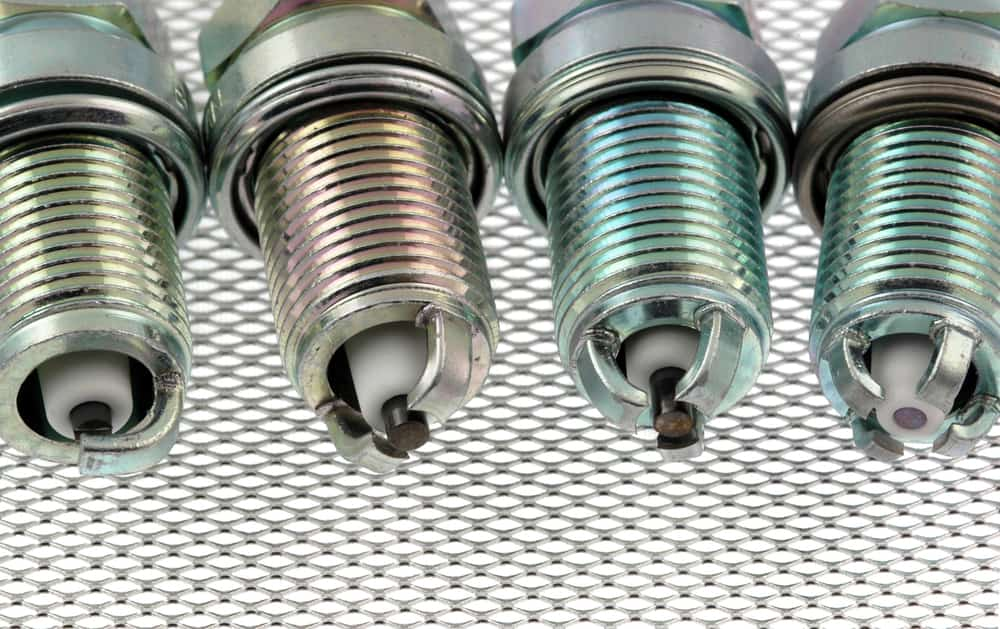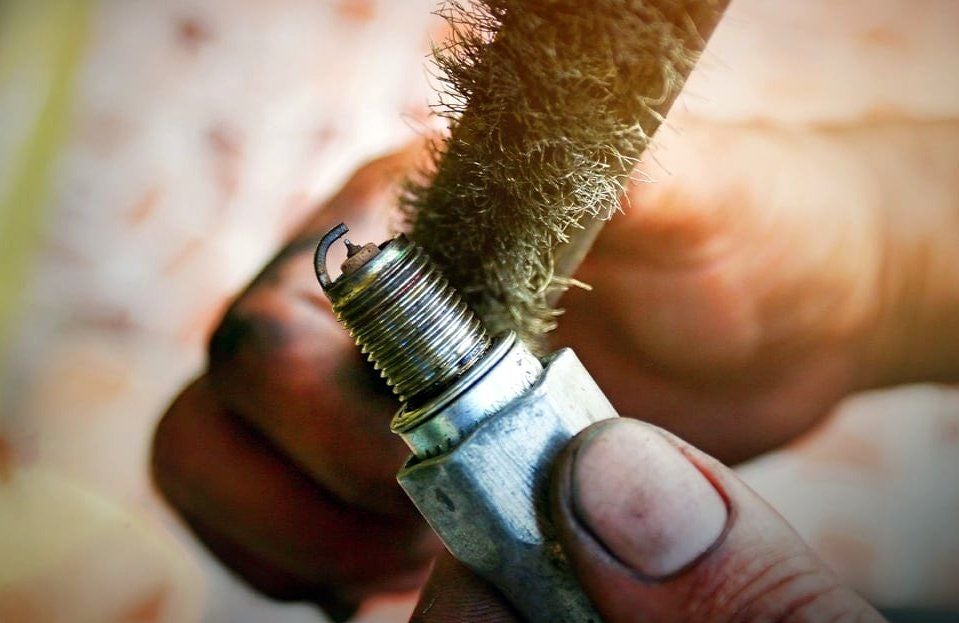In one of our previous articles, we covered how the combustion process occurs inside the engine. In the combustion section, we read about a device called the spark plug which provides the tiny spark necessary to start the process of combustion. In this article, we will dwell deeper into this very small yet powerful device. We will understand its basics, how it functions and have a look at its different types. We will also take a look at some simple maintenance tips that will help your car spark plug last longer and stay healthy.
Also Read: How to Make A Car Clutch Last Long 
What Are Spark Plugs?
As we discussed previously, the spark plug is the device responsible for starting the combustion process in a petrol engine. The spark plug consists of three primary layers. The outermost layer is a threaded metal shell which gives it structural integrity. Connected to this shell on one end is the side electrode which is grounded as it is connected to the metal casing. Inside the metal shell is a porcelain layer which acts as an insulating surface for the main electrode inside. Within this insulated porcelain casing lies the main electrode through which the current passes. This main electrode is completely electrically isolated from the side electrode with the help of the porcelain casing.
How Spark Plugs Work
The spark plug is connected to a high voltage source like the magneto or the ignition coil at one end. The other end with the two electrodes is immersed into the combustion chamber. When current passes through the terminal and into the main centre electrode, a potential difference (voltage drop) is created between two electrodes. The gas mixture that occupies the gap between them acts as an insulator and thus the electricity doesn’t flow beyond the tip of the centre electrode. But as the voltage increases, the gases in the gap begin to get energized. Once the voltage increases to the point that crosses the dielectric strength (resistance to conduct electricity) of the gases, they become ionized. Once the gases get ionized, they begin to act as conductors and permit the current to travel through the insulating gap. When the dielectric strength is crossed, the electrons begin to surge through that gap. This sudden movement of electrons rapidly increases the heat in that region due to which they begin to expand rapidly causing a mini explosion which results in the formation of a spark. [embed]https://www.youtube.com/watch?v=dea07uYGkps[/embed]
Video Courtesy: YouTube
Spark Plug Types
Spark Plugs can be put into two different primary classifications, based on their operating temperatures and based on their construction.
Based on Operating Temperatures
Once the combustion process is completed in the combustion cycle, the heat generated needs to dissipate. The heat escapes through the exhaust gases, the cylinder wall of the engine and the spark plug surface. Based on the operating temperature and level of heat dissipation, spark plugs can be classified into two types:
- Hot Spark Plug: A hot spark plug operates in a higher temperature range. It has a lesser ceramic area which is used to insulate the heat. A hot spark plug dissipates lesser combustion heat and allows the tip and electrode to stay hotter. This ensures that any deposit accumulation is burned off and isn’t allowed to stay for long.
- Cold Spark Plug: For high-performance engines that run hot by default, using a hot spark plug will cause pre-ignition. In extreme cases, it can also lead to the tip melting off. In such cases, a cold spark plug is used. Here the ceramic insulation area is higher and this it will dissipate more heat. But on the flipside, it is prone to greater deposit accumulation. Be sure to follow your instruction manual and use the correct type of plug recommended for your engine for optimum performance.
Based on Material Used
Spark Plugs are further classified based on the material used on the ends of the electrodes. They are of 4 types:
- Copper- Nickel Type: These are the most basic types of spark plugs. Here the centre electrode is made of a copper-nickel alloy as copper on its own is very weak and will melt off due to engine heat. Nickel is added to strengthen the plug but even then these are the weakest types available in the market. They are also required to be made with a larger diameter and hence require more voltage for operation.
- Single Platinum Type: These plugs have a small platinum disc on the tip of the centre electrode. This platinum tip is exponentially stronger than a copper-nickel coating making this type of plug last long as well. They are also less prone to debris build up.
- Double Platinum Type: These plugs have platinum tips on both the centre electrode and the side electrode. They spark up twice in the combustion cycle, once before the combustion and once during the exhaust stroke. The second spark is wasted and so this spark plug can only be used if your vehicle is equipped with a waste spark ignition type distributor.
- Iridium Type: These are the best spark plugs available in the market. Here the tip of the centre electrode is made of Iridium which is the strongest out of nickel, copper, and platinum. Hence, they are the least prone to deposits and damage. They also have a small sized electrode which requires less voltage for operation as well. Iridium plugs are much more expensive than the other types but then again you pay for what you get.
Spark Plug Problems and Maintenance:
Over time your car spark plug's health will begin to deteriorate. Manufacturers have their own recommended change intervals but ideally, your car’s spark plugs should last 20,000 km before requiring a change. The common indications that your car spark plugs require to be changed include:
- Rough Idling once you turn on your vehicle
- Car struggles during the first morning start
- Engine Misfiring
- Increased fuel consumption
- Decreased acceleration
- Sudden surges in power
Be wary of these indications as operating your car with a faulty spark plug causes improper combustion to occur. Even as they start to deteriorate, they begin to lose proper functioning. This has a potential of causing damage to various other parts of the engine. But with some simple periodic maintenance, you can greatly extend the life of your car’s spark plugs. This will allow you to save a lot of cash which you would otherwise end up spending on replacing the parts damaged due to faulty spark plugs.
Simple Tips to Boost Spark Plug Life:
- Choosing the Right Type: Before installing a spark plug, it is highly mandatory that you choose the correct type of spark plug for your vehicle. If you are choosing a cold spark plug for a low-performance engine, it will dissipate the heat too fast and cause a retarded spark release. Similarly, using a hot spark plug on a high-performance engine might just cause the tip to melt off in the heat. So be sure to use the correct type of plug recommended for your car’s engine.
- Clean off the Electrodes: Carefully remove the spark plug from its terminal using a dedicated spark plug socket wrench. Soak the plug in a thinner liquid like diesel, petrol or isopropyl alcohol solution. Next remove the hard, crusted deposit off the electrodes using a toothbrush or sandpaper. If the deposit is too hard, then you can use a wire brush but it isn’t highly recommended.
- Check the Spark Gap: The Spark Gap between the two electrodes is very crucial. If the gap is too less, the spark will be very weak. If it is too much, there might just be no spark at all. So check your owner’s manual or the internet to see how much the ideal spark gap should be. Use a coin/wire-coin type gap measure to check the gap width and make necessary adjustments accordingly. Be very careful while adjusting the gap of the side electrode as it can snap off very easily.
- Clean off the Mounting Area: As an added tip, clean off the area where the spark is mounted as well. With the accumulation combustion debris on the gap, it can cause the spark plug to get misaligned. Wipe off all the debris and oil from that area before mounting the spark plug back into position.













.webp&w=828&q=75)
-(1).webp&w=828&q=75)











.webp&w=640&q=75)
-(1).webp&w=640&q=75)








